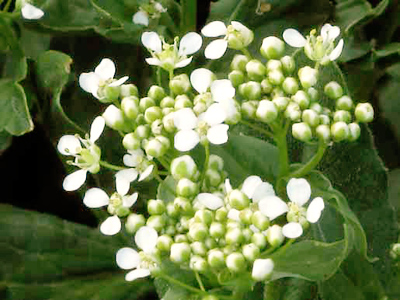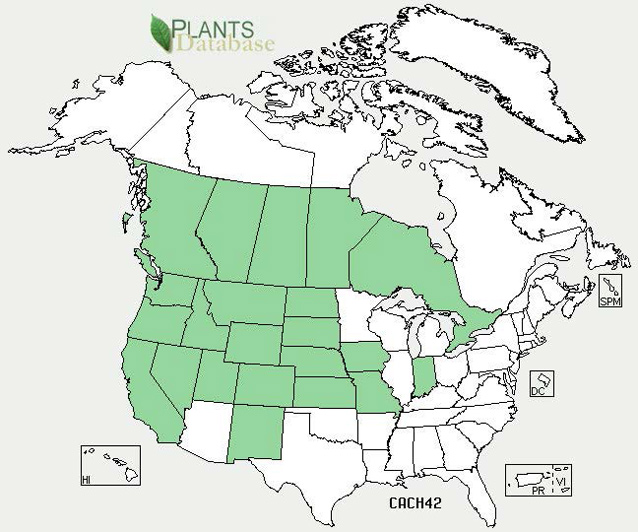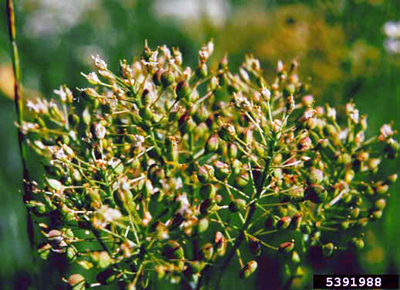Brassicaceae (Mustard family)
At a Glance

© Carol Jacobs-Carre
- Perennial
- Stout, erect, or trailing stems that can grow to 8-20 inches long.
- Stems are smooth towards the top and densely hairy towards the bottom.
- Leaves are generally 0.5 to 3 inches long, but can grow up to 4 inches long. The edges are either smooth or toothed.
- Flowers in spring with showy white flowers in a cluster of flat-topped racemes. Each flower is 2 mm wide and has four petals that are each shaped like a spoon.
- Fruit is shaped like an inverted heart.
Habitat and Ecology
Lens-podded hoary cress (Cardaria chalepensis) is found in most western states, except Arizona, where it has only a limited distribution. It is native to central Asia and most likely arrived in alfalfa seed from Turkestan in the early 1900s. Lens-podded hoary cress grows in a variety of soil types, including saline soils, but it prefers non-acidic soils. It is most aggressive in irrigated areas or during moist years. Once established, it forms dense infestations in meadows or fields.

USDA
Description
Lens-podded hoary cress is a perennial forb that generally has a gray-green, soft hairy appearance and can grow up to knee-height. Its stems are smooth towards the top and densely hairy towards the bottom. Lens-podded hoary cress develops extensive systems of persistent, long horizontal and vertical roots. Vertical roots can penetrate the soil to depths of greater than a foot. The plant tends to spread through vegetative reproduction from its rhizomatous roots, but it also spreads by seeds. Root fragments can be dispersed long distances through floods, and seeds are dispersed by water, vehicles, farm machinery, and contaminated hay and crop seeds. The seeds germinate well and can remain viable in the seedbank for several years.
Leaves
The lower leaves form a basal rosette, and the upper leaves clasp the stem and are often lobed at the bases. The leaves are simple and alternate. The upper leaves are 0.5 to 3.0 inches long, but can grow up to 4 inches. The edges are either smooth or toothed.

© John M. Randall , The Nature Conservancy
Flowers and Fruits
The flowers are white with four petals shaped like spoons. Each flower is 2 mm wide, and the sepals do not have hairs. The flowers form flat-topped clusters of racemes. They are pollinated by insects.
The fruit is an indehiscent silicle, or a roundish pod unique to the mustard family that does not open to release seeds. For lens-podded hoary cress, the fruit is oval and is shaped like an inverted heart. The valves fall away when the fruit is ripe. The fruit does not have hairs and is generally 1-2.3 inches long, but can be as long as 3 inches.
Etymology
Cardar’ia is Greek for “heart-shaped,” after the fruit. The -ensis ending in chalepensis is usually used to indicate the place of origin or habitat. Chalepensis could refer to either: Aleppo, Alep, or Haleb, a city in northwestern Syria about eighty miles inland from the Mediterranean Sea; or Khalepa, a city in Greece on the island of Crete near Canea.
Similar Species
Lens-podded hoary cress is easily misidentified in the field as heart-podded hoary cress (Cardaria draba) or globepodded hoary cress (Cardaria pubescens). Lens-podded hoary cress is slightly shorter than the other species, and it has an oval to lens-shaped fruit that has a longer style and does not narrow at the septum. When mature, the fruit does not deflate, and it does not have conspicuous veins once dry. Lens-podded hoary cress is also similar in appearance to perennial pepperweed (Lepidium latifolium), but perennial pepperweed has leaves without hairs, leaves that fully clasp around the stem, and fruits that open at maturity to release seeds.
Control Methods
Possible control methods are explained at these websites:
References
Arizona Wildlands Invasive Plant Working Group. 2004. Cardaria chalapensis Plant Assessment Form. Available at https://sbsc.wr.usgs.gov/research/projects/swepic/SWVMA/PLANTPDF/Cardaria_draba_AZ_PAF.pdf (accessed 3 March 2010).
California Department of Food and Agriculture. No date. Cardaria in Encyloweedia. Available at https://www.cdfa.ca.gov/plant/IPC/encycloweedia/weedinfo/cardaria.htm (accessed 5 March 2010).
Charters, M. L. 2009. California plant names: Latin and Greek meanings and derivations. Available at http://www.calflora.net/botanicalnames (accessed 5 March 2010).
Ghorbani, A. 2005. Studies on pharmaceutical ethnobotany in the region of Turkmen Sahra, north of Iran (Part 1): General results. Journal of Ethnopharmacology 102: 58-68.
Lyons, K. E. and Meyers-Rice, B. (editor). 1998. Cardaria spp. in Element Stewardship Abstracts. The Nature Conservancy, Arlington, VA. Available at: http://www.imapinvasives.org/GIST/ESA/esapages/documnts/card_sp.pdf.
Zouhar, K. 2004. Cardaria spp. in Fire Effects Information System. US Department of Agriculture, Forest Service, Rocky Mountain Research Station, Fire Sciences Laboratory. Available at https://www.fs.fed.us/database/feis (accessed 3 March 2010).
Prepared by Kelly Reeves, Southern Colorado Plateau Network Inventory and Monitoring Program, 2010.
Last updated: March 14, 2016
